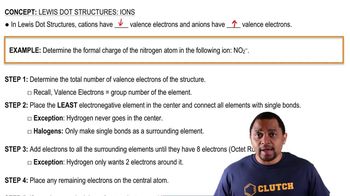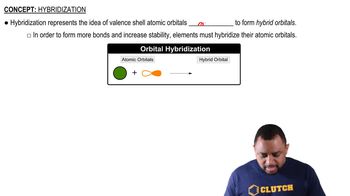One of the molecular orbitals of the H2- ion is sketched below: (d) Compared to the H¬H bond in H2, the H¬H bond in H2- is expected to be which of the following: (i) Shorter and stronger, (ii) longer and stronger, (iii) shorter and weaker, (iv) longer and weaker, or (v) the same length and strength?
Ch.9 - Molecular Geometry and Bonding Theories
Chapter 9, Problem 109b2
Azo dyes are organic dyes that are used for many applications, such as the coloring of fabrics. Many azo dyes are derivatives of the organic substance azobenzene, C12H10N2. A closely related substance is hydrazobenzene, C12H12N2. The Lewis structures of these two substances are

(Recall the shorthand notation used for benzene.) (b) How many unhybridized atomic orbitals are there on the N and the C atoms in each of the substances? How many unhybridized atomic orbitals are there on the N and the C atoms in hydrazobenzene?
 Verified step by step guidance
Verified step by step guidance1
Identify the hybridization of each carbon (C) and nitrogen (N) atom in both azobenzene and hydrazobenzene.
For azobenzene, note that each carbon in the benzene rings is sp2 hybridized, and the nitrogen atoms are also sp2 hybridized.
For hydrazobenzene, observe that the carbon atoms in the benzene rings remain sp2 hybridized, while the nitrogen atoms are sp3 hybridized due to the presence of single bonds and lone pairs.
Count the number of unhybridized p orbitals for each sp2 hybridized atom (each sp2 hybridized atom has one unhybridized p orbital).
Sum the unhybridized p orbitals for all the sp2 hybridized atoms in both azobenzene and hydrazobenzene to determine the total number of unhybridized atomic orbitals.

Verified Solution
Video duration:
3mWas this helpful?
Key Concepts
Here are the essential concepts you must grasp in order to answer the question correctly.
Lewis Structures
Lewis structures are diagrams that represent the bonding between atoms in a molecule and the lone pairs of electrons that may exist. They help visualize the arrangement of electrons and the connectivity of atoms, which is crucial for understanding molecular geometry and reactivity. In the context of azo dyes and hydrazobenzene, Lewis structures illustrate how atoms are bonded and the distribution of electrons, aiding in the analysis of hybridization and orbital characteristics.
Recommended video:
Guided course

Lewis Dot Structures: Ions
Hybridization
Hybridization is the concept of mixing atomic orbitals to form new hybrid orbitals that can accommodate the bonding requirements of atoms in a molecule. For example, carbon atoms in organic compounds often undergo sp3, sp2, or sp hybridization, depending on their bonding environment. Understanding hybridization is essential for determining the geometry of molecules and the number of unhybridized orbitals, which is a key aspect of the question regarding the nitrogen and carbon atoms in hydrazobenzene.
Recommended video:
Guided course

Hybridization
Unhybridized Atomic Orbitals
Unhybridized atomic orbitals are the orbitals that remain in their original state after hybridization has occurred. These orbitals are important for understanding the bonding and lone pairs in a molecule. In the case of hydrazobenzene, identifying the number of unhybridized orbitals on the nitrogen and carbon atoms is crucial for predicting the molecule's reactivity and interaction with other substances, particularly in the context of azo dye applications.
Recommended video:
Guided course

Atomic Orbitals Example
Related Practice
Textbook Question
570
views
Textbook Question
Place the following molecules and ions in order from smallest to largest bond order: N22+, He2+, Cl2 H2-, O22-.
840
views
1
rank
Textbook Question
Molecules that are brightly colored have a small energy gap
between filled and empty electronic states (the HOMOLUMO
gap; see Exercise 9.104). Suppose you have two samples,
one is lycopene which is responsible for the red color
in tomato, and the other is curcumin which is responsible
for the yellow color in turmeric. Which one has the larger
HOMO-LUMO gap?
490
views
Textbook Question
Azo dyes are organic dyes that are used for many applications, such as the coloring of fabrics. Many azo dyes are derivatives of the organic substance azobenzene, C12H10N2. A closely related substance is hydrazobenzene, C12H12N2. The Lewis structures of these two substances are
(Recall the shorthand notation used for benzene.) (c) Predict the N¬N¬C angles in each of the substances.
513
views
Textbook Question
a) Using only the valence atomic orbitals of a hydrogen
atom and a fluorine atom, and following the model of
Figure 9.46, how many MOs would you expect for the HF
molecule?
647
views
Textbook Question
Carbon monoxide, CO, is isoelectronic to N2. (d) Would you expect the p2p MOs of CO to have equal atomic orbital contributions from the C and O atoms? If not, which atom would have the greater contribution?
1217
views
